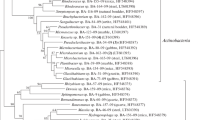Abstract
A sulphate-reducing consortium used in a bioprocess to remove toxic metals from solution as insoluble sulphides, was characterised using molecular (PCR-based) and traditional culturing techniques. After prolonged cultivation under anoxic biofilm-forming conditions, the mixed culture contained a low diversity of sulphate-reducing bacteria, dominated by one strain closely related to Desulfomicrobium norvegicum, identified by three independent PCR-based analyses. The genetic targets used were the 16S rRNA gene, the 16S-23S rRNA gene intergenic spacer region and the disulfite reductase (dsr) gene, which is conserved amongst all known sulphate-reducing bacteria. This organism was also isolated by conventional anaerobic techniques, confirming its presence in the mixed culture. A surprising diversity of other non-sulphate-reducing facultative and obligate anaerobes were detected, supporting a model of the symbiotic/commensal nature of carbon and energy fluxes in such a mixed culture while suggesting the physiological capacity for a wide range of biotransformations by this stable microbial consortium.
Similar content being viewed by others
References
Bache R and Pfennig N. (1981). Selective isolation of Acetobacterium woodii on methylated aromatic acids and determination of growth yields. Arch Microbiol 130: 255–261
Barnes LJ, Scheeren PJ and Buisman CJN (1994). Microbial removal of heavy metals and sulfate from contaminated groundwaters. In: Means, JL and Hinchee, RE (eds) Emerging Technology for Bioremediation of Metals, pp 38–49. Lewis Publisher, Boca Raton, USA
Chang Y-J, Peacock AD and Long PE (2001). Diversity and Characterization of Sulfate-Reducing Bacteria in Groundwater at a Uranium Mill Tailings Site. Appl Environ Microbiol 67: 3149–3160
Dejonghe W, Berteloot E and Goris J (2003). Synergistic Degradation of Linuron by a Bacterial Consortium and Isolation of a Single Linuron-Degrading Variovorax Strain. Appl Environ Microbiol 69: 1532–1541
Drury WJ. (1999). Treatment of acid mine drainage with anaerobic solid-substrate reactors. Water Environ Res 71: 1244–1250
Edwards U, Rogall T, Blocker H, Emde M and Bottger EC. (1989). Isolation and direct nucleotide determination of entire genes.Characterisation of a gene coding for 16S ribosomal RNA. Nucleic Acids Res 17: 7843–7853
Hippe H, Vainshtein M, Gogotova GI and Stackebrandt E. (2003). Reclassification of Desulfobacterium macestii as Desulfomicrobium macestii comb. nov. J Syst Evol Microbiol 53: 1127–1130
Hockin SL and Gadd GM. (2003). Linked Redox Precipitation of Sulfur and Selenium under Anaerobic Conditions by Sulfate-Reducing Bacterial Biofilms. Appl Environ Microbiol 69: 7063–7072
Holt JG. (1994). Bergeys Manual of Determinative Bacteriology. Williams and Wilkins, Baltimore
Islam F, Gault AG and Boothman C (2004). Role of metal-reducing bacteria in arsenic release from Bengal Delta sediments. Nature 430: 68–71
Kolmert A and Johnson DB. (2001). Remediation of acidic waste waters using immobilised, acidophilic sulfate-reducing bacteria. J Chem Technol Biotechnol 76: 836–843
Lloyd JR, Lovley DR and Macaskie LE. (2004). Biotechnological application of metal-reducing bacteria. Adv Appl Microbiol 53: 85–128
Ranjard L, Poly F, Lata J, Mougel C, Thioulouse J and Nazaret S. (2001). Characterization of bacterial and fungal soil communities by automated ribosomal intergenic spacer analysis fingerprints: Biological and methodological variability. Appl Environ Microbiol 67: 4479–4487
Rabus R, Fukui M, Wilkes H and Widdle F. (1996). Degradative capacities and 16S rRNA-targeted whole-cell hybridization of sulfate-reducing bacteria in an anaerobic enrichment culture utilizing alkylbenzenes from crude oil. Appl Environ Microbiol 62: 3605–3613
Schnell S, Bak F and Pfennig N. (1989). Anaerobic degradation of aniline and dihydroxybenzenes by newly isolated sulphate-reducing bacteria and description of Desulfobacterium anilini. Arch Microbiol 152: 556–563
Schulz S, Dong W, Groth U and Cook AM. (2000). Enantiomeric degradation of 2-(4-sulfophenyl)butyrate via 4-sulfocatechol in Delftia acidovorans SPB1. Appl Environ Microbiol 66: 1905–1910
Terzenbach DP and Blaut M. (1994). Transformation of tetrachloroethylene to trichlororethylene by homoacetogenic bacteria. FEMS Microbiol Lett 123: 213–218
Wagner M, Roger AJ, Flax JL, Brusseau GA and Stahl D. (1998). Phylogeny of dissimilatory sulfite reductases supports an early origin of sulfate respiration. J Bacteriol 180: 2975–2982
White C and Gadd GM. (1996). A comparison of carbon/energy and complex nitrogen sources for bacterial sulphate reduction: potential applications to bioprecipitation of toxic metals as sulphides. J Indust Microbiol Biotechnol 17: 116–123
White C and Gadd GM. (1996). Mixed sulphate-reducing bacterial cultures for bioprecipitation of toxic metals: factorial and response-surface analysis of the effects of dilution rate, sulphate and substrate concentration. Microbiol 142: 2197–2205
White C, Gadd GM. (1998). Reduction of metal cations and oxyanions by anaerobic and metal-resistant microorganisms: chemistry, physiology and potential for the control and bioremediation of toxic metal pollution. In: Horikoshi K, Grant WD, eds. Extremophiles: Physiology and Biotechnology. New York: John Wiley and Sons; 233–254
White C and Gadd GM. (2000). Copper accumulation by sulphate-reducing bacterial biofilms and effects on growth. FEMS Microbiol Lett 183: 313–318
White C, Sharman AK and Gadd GM. (1998). An integrated microbial process for the bioremediation of soil contaminated with toxic metals. Nature Biotechnol 16: 572–575
White C, Dennis JS and Gadd GM. (2003). A mathematical process model for cadmium precipitation by sulfate-reducing bacterial biofilms. Biodegrad 14: 139–151
Widdel F and Pfennig N. (1981). Studies on dissimilatory sulfate-reducing bacteria that decompose fatty acids. 1. Isolation of new sulfate-reducing bacteria enriched with acetate from saline environments - description of Desulfobacter postgatei gen. nov., sp. nov. Arch Microbiol 129: 395–400
Author information
Authors and Affiliations
Corresponding author
Rights and permissions
About this article
Cite this article
Boothman, C., Hockin, S., Holmes, D.E. et al. Molecular analysis of a sulphate-reducing consortium used to treat metal-containing effluents. Biometals 19, 601–609 (2006). https://doi.org/10.1007/s10534-006-0006-z
Received:
Accepted:
Published:
Issue Date:
DOI: https://doi.org/10.1007/s10534-006-0006-z




